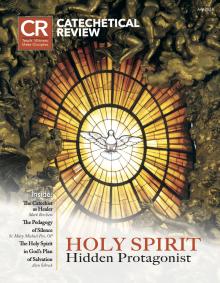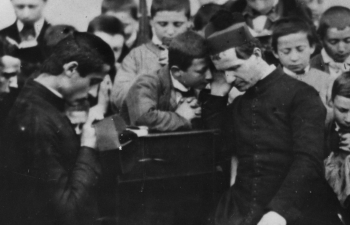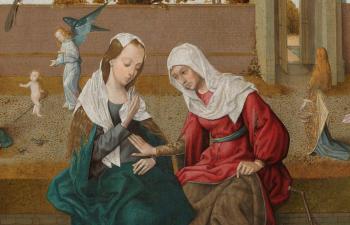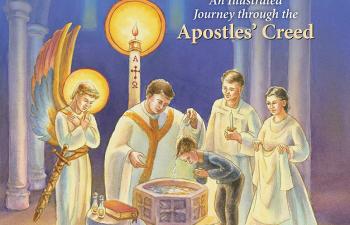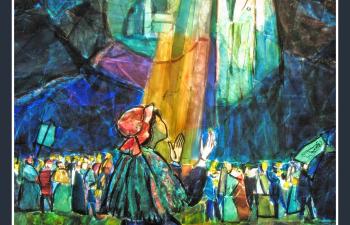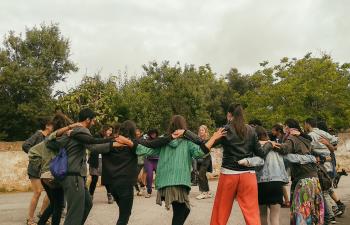
Several years ago, I stepped into another sister’s classroom to drop something off and found her seated on a low chair near the sacred space, her students on the carpet at her feet. She had an image of Fra Angelico’s Annunciation prominently displayed, but they were talking about the bells at Mass. “The bells are like the doorbell,” she was saying. “When the doorbell rings you know someone is there to see you. When the bells ring at Mass, they tell us that God is here.” I was intrigued, and, since I had a few minutes, I sat down to watch.
I soon realized this wasn’t a lesson on the annunciation, despite the image on the board, nor on the Real Presence, as the bells might lead you to think. As Sister moved her hands into the liturgical gesture of the epiclesis, they reviewed what they already knew about this moment in the liturgy. Their young minds were being stretched to move from sign to reality as they struggled to grasp why the bells were rung at this moment in the Mass. Then there was a quiet gasp, and another, and another. Some squirmed and others sat up a little straighter. Hands shot up into the air. “The Holy Spirit is there. He’s really there,” a child whispered. “He’s invisible, but he’s there!” another said. The children gazed and smiled, too excited to speak, delighting, as only children do, in the wonder of discovery.
That cry of faith has stayed with me over the years and can serve as a mirror for our own work of catechesis. The Holy Spirit is invisible yet present, the one who precedes, accompanies, and perfects all our efforts, the hidden protagonist of all catechesis.
O Most Blessed Light Divine
The Holy Spirit’s action in the work of catechesis is first in every sense of the word. Catechesis aims “to put people not only in touch but in communion, in intimacy, with Jesus Christ,”[1] a reality that can only happen after one has “been touched by the Holy Spirit” (CCC 683). The gift of faith is that touch, an awakening to supernatural light. St. Clement of Alexandria wrote, “Everything is illuminated when the true light rises.”[2] Just as lines sharpen and colors brighten in the dawning light of morning, catechesis allows the light of the Holy Spirit to dawn upon all things, revealing their true meaning. An insight from St. Irenaeus can be helpful in clarifying the role of the catechist: we are the “beneficiaries,” and not the sources, of the light; for those “who are in the light do not illuminate the light but are themselves illuminated and enlightened by the light. They add nothing to the light.”[3]
I have often watched my teenage students stumble in the fog of confusion, doubt, or outright unbelief. No effort on my part can produce in them the light that scatters that darkness; that is the action of the Holy Spirit. I add nothing to the light. The heart is his realm, his dwelling place:
O most blessed Light divine,
Shine within these hearts of yours,
And our inmost being fill![4]
In his goodness to me, the Lord invites me to unite my small actions to his so that his salvific work is accomplished in and through my cooperation. A catechesis attentive to the primacy of grace and the Holy Spirit is above all a spiritual activity in which God is about something far greater than we can ever imagine.
Pour Your Dew
When you grow up in the Pacific Northwest, you experience lots of precipitation in all its forms and moods. So the Old Testament passages where the educative and salvific action of God is described in the language of Word and water resonate in my mind. The Word of the Lord goes forth from his mouth, finding soil made ready and fertile by the water of the Spirit. As a little girl, I found the morning dew entrancing—tiny, glistening droplets coating every pebble, each blade of grass, even a spider’s web.
The Holy Spirit’s presence in the soul has the delicacy of dew. The condescension manifested by the Son in the Incarnation is indeed marvelous to behold: “Lo! Within a manger lies / he who built the starry skies.”[5] But the “divine self-effacement” of the Spirit is perhaps even more marvelous, for he is so hidden that we recognize his presence only by his effects (CCC 687). Jesus Christ can and does say, “Come to me” (Mt 11:28); yet, the Spirit “will not speak on his own” (Jn 16:13). He dwells within the Christian as in a temple, always acting in us, revealing the Son to us, directing us toward the Father, filling us with grace, inspiring us to do good, all the while eliciting and enhancing our freedom. The Directory for Catechesis tells us that this divine pedagogy of the Spirit possesses “great value” for the Church and serves as the inspiration and animating principle of her catechesis.[6]
A catechesis inspired and enlivened by the inner Pedagogue will be characterized by trust. One year as I worked through letters of recommendation, I realized how many students were going on to secular schools, where no one else would teach them religion. In a moment of panic, I saw all that was still undone and was soon overwhelmed with a sense of urgency—this was my last chance! Mercifully, grace intervened. I experienced a moment of conviction, an inner voice asking me if I believed in the objectivity of Baptism and Confirmation. It was as if the Holy Spirit was saying, “I've got this.” He was with them and would be with them long after they left me. My task was to entrust myself and them to his providential care, praying:
Heal our wounds, our strength renew;
On our dryness pour your dew;
Wash the stains of guilt away:
Bend the stubborn heart and will;
Melt the frozen, warm the chill;
Guide the steps that go astray.[7]
Flaming and Yet Unburned
I didn’t stay long in Sister’s classroom that day, but I didn’t need to in order to understand why she had Fra Angelico’s Annunciation on the board. Angelico’s paintings are contemplative and serene, and in this one, the Holy Spirit is hardly visible in the heavenly light streaming from the Father’s outstretched hands. The starry dome above Our Lady illumines the mystery that the one whom the heavens cannot contain will be contained in her womb.
The Holy Spirit is the inner Pedagogue, bringing about the work of transformation and sanctification. As fons vivus, ignis, caritas, his life is fire and love.[8] When we are not yet converted to the logic of gift, that fire of love frightens us; we see its blaze and worry that it will burn us, forgetting that it is only the dross of sin that turns to dust and ashes. Our Lady, our “living catechism,” [9] was freed from even the shadow of sin. Her experience of the fire of love was as gentle as the dew, and the transformation was immediate and complete. Her beauty is transparent, perfect claritas, revealing the presence of God hidden within, making her the radiant sign of “the definitive theophany” of the New Law (CCC 724).[10] She is “like the bush, flaming and yet unburned,”[11] the lamp—no, the fire—set before us so that we may glorify the heavenly Father in seeing her goodness (Mt 5:14–16, Lk 1:46–49). The catechist attentive to the Spirit has this Marian attitude: complete trust in the Spirit’s action bringing Christ to birth in us, followed by the joyful proclamation of his presence and nearness. In contemplating her, we behold what is most authentically human, the radiant beauty of a life that proclaims that the Holy Spirit is here.
Sr. Jude Andrew Link, OP, entered the Dominican Sisters of Mary, Mother of the Eucharist in 2003. She has an MA in theology and is pursuing an MA in Catechetics and Evangelization from Franciscan University. She taught middle school and high school and has worked with Openlight Media, an apostolate of her community, developing catechetical resources for teachers.
Notes
[1] St. John Paul II, Catechesi Tradendae, no. 5.
[2] St. Clement of Alexandria, Stromateis bk. 1, ch. 13, no. 57.1.
[3] St. Irenaeus, Against Heresies, quoted in Office of Readings, Saturday after Ash Wednesday.
[4] “Veni Sancte Spiritus,” sequence for Pentecost Sunday, Daily Roman Missal: Complete with Readings in One Volume (Woodridge, IL: Midwest Theological Forum, 2011), 701.
[5] Edward Caswall, “See Amid the Winter’s Snow,” The New Oxford Book of Carols, eds. Hugh Keyte and Andrew Parrott (New York: Oxford University Press, 1998), 340–41.
[6] Pontifical Council for the Promotion of the New Evangelization, Directory for Catechesis (Washington, DC: United States Conference of Catholic Bishops, 2020), 163.
[7] “Veni Sancte Spiritus.”
[8] “Veni Creator Spiritus,” Vespers hymn for Pentecost and used for other solemn invocations of the Holy Spirit, such as Confirmation and Holy Orders. Literally “font of life, of fire, of love,” but typically translated as “O font of life and fire of love.”
[9] John Paul II, Catechesi Tradendae, no. 73.
[10] See St. Thomas Aquinas, Summa Theologiae I, q. 39, a. 8; I-II, q. 27, a. 1, ad 3.
[11] Third Antiphon at Vespers on the Solemnity of Mary, the Holy Mother of God.
This article originally appeared on pages 14-16 of the print edition.
Art credit: Fra Angelico’s Annunciation, Wiki Media Commons
This article is from The Catechetical Review (Online Edition ISSN 2379-6324) and may be copied for catechetical purposes only. It may not be reprinted in another published work without the permission of The Catechetical Review by contacting [email protected]


